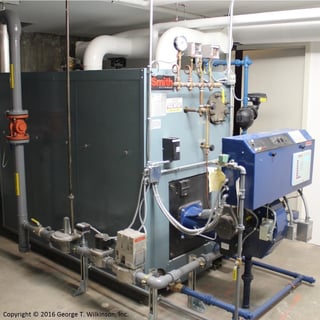Turndown has been a trending topic in the boiler industry for many years but is it as important as we think?
What is boiler turndown? Boiler turndown is the ratio that a boiler can fire at full capacity to its lowest firing rate before the system shuts down. For example, if a boiler is a 1 million BTU boiler that can fire as low as 250,000 BTUs, then the boiler has a 4:1 turndown ratio.
Boiler turndown certainly has an effect on efficiency, but for each application that effect could be different. There are three major elements that are impacted by a boiler’s turndown; boiler loads, operating cycles, and overall efficiency.
The size of a boiler’s load can impact whether or not a high turndown boiler is the best fit. For a boiler with a large load at high fire that is expected to meet various loads throughout the range, a high turndown system is recommended. A boiler operating with a high turndown burner will only use the required energy and fuel needed to meet the desired load at each firing rate. In this scenario, it is essential to ensure that the boiler is properly sized.
Boiler turndown also effects the operating cycles of the system. A boiler that has a higher turndown will cycle less than a boiler with a low turndown, depending on whether the system was properly sized and designed. Typically, a boiler should not cycle very often because by law,  facilities must ensure, at minimum, four air changes within the boiler to remove any explosive or harmful gases. This process will remove heat from the boiler and as a result, the boiler will be less efficient when starting back up.
facilities must ensure, at minimum, four air changes within the boiler to remove any explosive or harmful gases. This process will remove heat from the boiler and as a result, the boiler will be less efficient when starting back up.
However, there are times when it would be more efficient to shut off the boiler completely. Rather than firing on low fire for an extended period of time because most burners increase excess air at the lower end, it can be more beneficial to have the boiler shut down to conserve fuel and energy. This is often the case with a lead lag boiler system. Rather than having a lag boiler set up with high turndown and waste fuel, it is more cost effective to shut that boiler off completely when it is not needed.
The overall efficiency of the boiler is not strictly dependent on the turndown, but turndown definitely plays a role. The boiler must be appropriately installed, sized, designed and controlled in order to fully utilize the efficiency of turndown. Every application is different and has different variables that effect the efficiency of the boiler. This means that some projects are better fit for a boiler with a 10:1 turndown and others for a boiler with a 4:1 turndown. Paying close attention to detail when designing various projects will pay off in the end.
To fully utilize boiler turndown, it is important to have a capable control system. Older boilers often have a low fire setting and high fire setting which are controlled by cams, rods and linkages. Cams, rods and linkages often make it difficult to control air to fuel ratios due to the lack of precision in making adjustments. Modern boiler controls use servomotors to control the fuel to air to fuel ratios. This allows the system to make clean, precise adjustments. Depending on the demand of the boiler, this can ultimately result in a more efficient system.
Is your boiler outdated? Upgrading your control system will maximize the efficiency of your boiler. Contact us to learn more.






